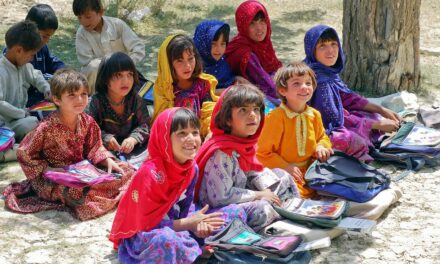THE ERA OF THE PROPHET (ﷺ) 609-632 CE
The Qur’aan was revealed to Prophet Muhammad (ﷺ) in sections throughout the twenty-three years of his prophethood. Whenever a problem arose or whenever Allaah wanted to give the Prophet (ﷺ) and his follower’s special advice, Allaah would send angel Jibreel with a part of the Qur’aan, which he would recite to the Prophet (ﷺ). Thus, the Qur’aan was not revealed all at once in its complete form like the earlier books of revelation, but in parts over a period of time.
Preservation of the Qur’aan
When Jibreel first recited a part of the Qur’aan to the Prophet (ﷺ), the Prophet (ﷺ) tried to repeat it after him, word for word. Allaah later had Jibreel tell him not to do so. He was told instead to listen to the Qur’aan carefully. When the Prophet (ﷺ) did that, Allaah caused him to be able to remember everything without any effort on his part. Allaah said in the Qur’aan,
“Do not move your tongue to hastily (learn) it. Surely I will collect and recite it. So, when I recite it, follow its recital.”
It was very important that the Prophet (ﷺ) remember all that was revealed to him, because he could neither read nor write.The Prophet (ﷺ) passed on all of the Qur’aan to his companions before he died. He used a number of different ways to make sure that they memorized and recorded it exactly as he learned it.
- The Prophet (ﷺ) used to recite aloud various parts of the Qur’aan in the salaahs (congregational prayers). In that way, his followers used to hear parts of the Qur’aan daily.
- Everyone who entered Islaam would be taught parts of the Qur’aan that they would have to use in their daily prayers. Thus, Muslims were always learning or teaching various parts of the Qur’aan.
- The Prophet (ﷺ) informed his followers that the best of them were those who learned and taught the Qur’aan. This encouraged them to make even greater efforts to memorize the Qur’aan and teach it to others.
- Those who were able to read and write were told by the Prophet (ﷺ) to write down the various sections of the Qur’aan as they were revealed.
- The Prophet (ﷺ) would tell them the order in which they should record the verses. Al-Baraa’ ibn ‘Aazib stated that when the verse, “Those believers who sit (at home) are not equal with those who strive,” was revealed, the Prophet (ﷺ) said, “Call So-and-so.” He came with an inkpot and a wooden board or a shoulder blade. The Prophet (ﷺ) said, “Write: ‘Those believers who sit (at home) are not equal with those who strive in the cause of Allaah…’ ”
Because there was no paper in Arabia at that time, the Qur’aan was written down on anything that was available. The companions wrote the verses of the Qur’aan on date palm leaves, flat stones, tree bark, wood, dried animal skins, and even the shoulder blades of sheep or camels.
Thus, the verses of the Qur’aan were preserved in the hearts of Muslims, as well as written down, during the lifetime of the Prophet (ﷺ). Since people entered Islaam at various points during the Prophet’s mission, only a few of them heard all of the Qur’aan directly from the Prophet (ﷺ).
Some companions were able to memorize better than others. So, even though all of them memorized portions of the Qur’aan, only a few were able to memorize all of the Qur’aan during the Prophet’s lifetime.
When the Prophet (ﷺ) died in the year 632 CE, the whole of the Qur’aan was not written down in one complete book. It was recorded on various pieces of writing material and kept in the possession of different followers of the Prophet (ﷺ). Each had sections, but none of them had all of it.
Because of the fact that the verses of the Qur’aan continued to be revealed up until a few months before the Prophet’s death, the companions were more concerned with recording and memorizing than putting it all together in one book. Consequently, the gathering of the Qur’aan into one text was not done during the lifetime of the Prophet (ﷺ).
THE ERA OF ABOO BAKR 632-634 CE/11-13 AH
After the death of the Prophet (ﷺ), there arose three main groups opposed to Islaam in the Arabian peninsula:
- The first group was made up of those who decided that they did not want to pay the Islaamic tax, zakaah, to anyone other than the Prophet (ﷺ).They did not feel that zakaah was a pillar of Islaam like salaah, sawm and hajj. They instead looked at zakaah as a tribute; a kind of tax paid to the one who conquered them.
- So, when the Prophet (ﷺ) died, they felt that they were no longer required to pay it. When Aboo Bakr became the leader of the Muslim state, this group refused to pay the zakaah and sent armies to the capital, Madeenah, in order to topple the Muslim state. They demanded to be excused from paying zakaah, or else they would attack and destroy the centers of Islaam.
- The first group was joined by those who had entered Islaam in order to escape defeat, as well as those who simply wanted to be on the winning side. This group did not believe in Allaah and His Messenger at all. They wanted to destroy Islaam so they could be free to do whatever they wanted to do. Since the armies of those who refused to pay zakaah appeared strong, many of these hypocrites joined them.
- The third group was made up of a number of false prophets and prophetesses and their followers. In Najd, in the region of Yamaamah, an Arab from the tribe of Banoo Haneefah named Musaylamah claimed prophethood.
- In the southern part of Arabia, another Arab from the tribe of ‘Ans called al-Aswad claimed prophethood and took over Najraan and Yemen.
- In northern Arabia a woman named Sajaah from the Banoo Tameem tribe also claimed prophethood and rose in arms against the Muslim state. These false prophets all invited people to leave Islaam by claiming that Allaah had revealed new laws to them making allowable most of the things which were forbidden by Allaah through Prophet Muhammad (ﷺ).
True Muslims under the leadership of Caliph Aboo Bakr were forced to fight these three groups in order to reestablish Islaam throughout the Arabian peninsula.
The First Writing
During these wars, known as the Riddah (apostasy), many of those who had memorized large portions of the Qur’aan were killed.Those Muslims who had a lot of Qur’aan in their hearts knew well the rewards which Allaah has promised those who fight for Islaam, so they would always be in the front lines of all the battles.
‘Umar ibn al-Khattaab realized the danger of what was happening and feared that if something was not done immediately, the Qur’aan would be lost to future generations of Muslims. He went to Caliph Aboo Bakr and advised him to have the whole Qur’aan written down in one book in order to preserve it from being lost.
Aboo Bakr at first refused to do so, as the Prophet (ﷺ) had not told them to do it. He was afraid of bringing anything new into the religion, because the Prophet (ﷺ) had warned them about changing the religion.
He knew that the Christians had gone astray before them by changing the religion which Prophet ‘Eesaa had brought after he left them, so Aboo Bakr was very much against making any changes in the religion as it had been left by Prophet Muhammad (ﷺ). However, after thinking over the situation carefully, he came to realize that ‘Umar’s advice was right and that it was not really a change in the religion.
The Prophet (ﷺ) had ordered them to write down the various verses and chapters of the Qur’aan while it was being revealed in order to help preserve it. Compiling all of what was written into one complete book was then only the completion of what the Prophet (ﷺ) had begun.
Caliph Aboo Bakr asked Zayd ibn Thaabit to be in charge of collecting and writing down the whole Qur’aan. Zayd refused to do it at first for the same reasons Aboo Bakr had, but after some time he also came to realize that it was right. Zayd was chosen for this task for the following reasons:
- He was one of the best reciters of the Qur’aan.
- He was one of the few who had memorized the whole Qur’aan during the lifetime of the Prophet (ﷺ).
- He was one of those whom the Prophet (ﷺ) asked to write down the Qur’aan.
- He was one of the few who were present when the Prophet (ﷺ) recited the whole Qur’aan during the last Ramadaan of his life.
Zayd began the process by collecting all of the materials on which the Qur’aan had been written. He then gathered around him all of those who had also memorized all of the Qur’aan or large portions of it. He then compared what was written down with what he and the others had memorized.
If all agreed, he would then write it down on pages of leather. In this way the whole Qur’aan was written down during the reign of the first Caliph. On its completion Zayd turned it over to Caliph Aboo Bakr, who kept it until his death two years after he had become Caliph.
Just before his death, Aboo Bakr turned over the Qur’aan to ‘Umar, whom he had chosen to be the second Caliph. ‘Umar kept his copy of the Qur’aan with him until his death, ten years later, at the hand of an assassin named Aboo Lu’lu’.The Qur’aan was then turned over to his daughter Hafsah, who was one of the Prophet’s widows. Hafsah kept the Qur’aan in her house in Madeenah, but she made it available to anyone who wanted to make copies from it or check the accuracy of what they had memorized.
THE ERA OF ‘UTHMAAN 644-656 CE/23-35 AH
After the death of the second Caliph, ‘Umar ibn al-Khattaab, a committee made up of six of the most famous companions of the Prophet (ﷺ) chose ‘Uthmaan ibn ‘Affaan to be the third caliph.
During the reign of Caliph ‘Umar (634-644 CE/13-23 AH), the Islaamic state had expanded beyond the borders of the Arabian peninsula into Egypt, Syria and ‘Iraaq. In the subsequent reign of Caliph ‘Uthmaan, the expansion continued on into Persia, India, Russia, China, Turkey and across North Africa.
Many of the people of these regions accepted Islaam and learned the recitation of the Qur’aan from the early Muslims. The Qur’aan was revealed to the Prophet (ﷺ) in seven different Arabian dialects, and the early Muslims taught the Qur’aan in its different readings.
The Second Writing
In the Muslim provinces, some Arabs began to boast that their dialect was superior to that of the others. Also, when new Muslims made mistakes in their recitation of the Qur’aan, it was sometimes difficult to tell whether it was really an error or whether it was one of the seven reading which had been taught by the Prophet (ﷺ).
These problems eventually became a source of confusion in the Muslim provinces outside of Arabia. One of the sahaabah by the name of Huthayfah ibn al-Yamaan noticed the confusion while he was in ‘Iraaq, and feared that it might lead to a breakup of the Muslim nation and the changing of the Qur’aan.
On his return to the capital, he informed Caliph ‘Uthmaan of what he had heard and seen. Caliph ‘Uthmaan realized the seriousness of the situation and called the major sahaabah together in order to find a solution to the problem. They decided to make official copies of the Qur’aan from the one compiled in Caliph Aboo Bakr’s time and limit the people to its recitation.
‘Uthmaan asked Hafsah for the original copy of the Qur’aan and called on Zayd ibn Thaabit to head a committee of four Qur’aanic scholars who would take on the task of making the official copies.When the copies were completed, the original was returned to Hafsah.
A total of seven copies were made and one was sent to Makkah, another to Syria, one to Basrah, one to Koofah, one to Yemen, one to Bahrayn, and one was kept in the capital, Madeenah. Apparently, different copies were written by different members of the committee.
Caliph ‘Uthmaan sent an official reciter of the Qur’aan with each copy in order to clear up any problems which might later arise.He also ordered that all other copies of the Qur’aan be destroyed, as people had made notes on their personal copies and some copies were incomplete.
All new copies were then made from the official copy, called Mus– haf ‘Uthmaan. In that way the Qur’aan was saved from any kind of change or loss. This process was completed in the year 646 CE, two years after ‘Uthmaan became the new Caliph.
Want to buy the finest products from Kashmir?







Recent Comments